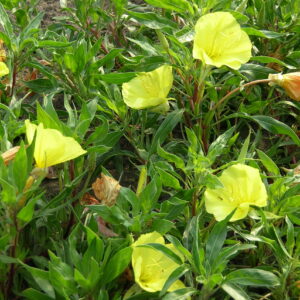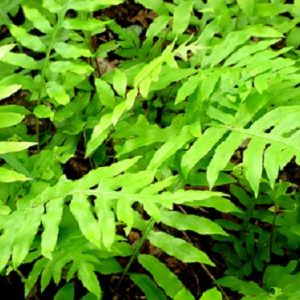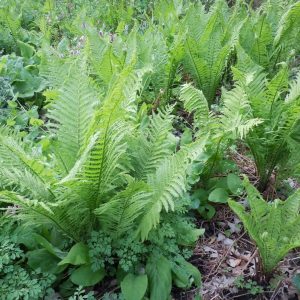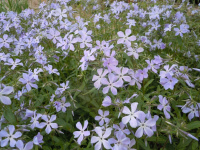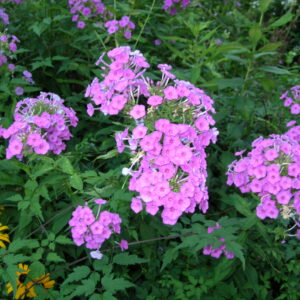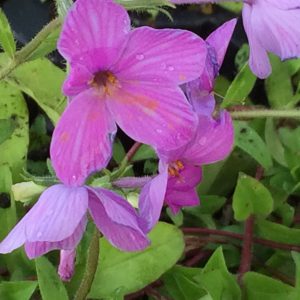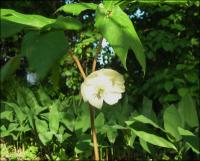Black Walnut Tolerant
Showing 65–72 of 106 results
-
Oenothera macrocarpa syn. O. missouriensis Ozark sundrops Z 3-7
Big, lemon-yellow blossoms much of the summer, then turn into curious-looking, big oval seed pods
Big, lemon-yellow blossoms much of the summer, then turn into curious-looking, big oval seed pods
Size: 9-12" x 12"
Care: sun in well-drained soil
Native: Missouri & Nebraska
Awards: Royal Horticultural Society Award of Merit.Oenothera is Greek meaning wine tasting referring to the ancient use of Sundrop roots. This discovered in 1810 by Thomas Nuttall when he traveled along the Missouri River “on the elevated summits of the …hills in the vicinity of the lead-mines of the river Meremeck, 30 miles from St. Louis, Louisiana.” (then in the Louisiana Territory). Nuttall described it as a “splendid and singular species.”
-
Onoclea sensibilis Sensitive fern Zones 4-10
Medium green fronds grow with deep curves along the wide stem then grow outward with lance-shaped fronds with wavy leaf margins. Don’t be fooled by the name sensitive. This is a tough fern growing just about any place with some shade.
OUT OF STOCK
Medium green fronds grow with deep curves along the wide stem then grow outward with lance-shaped fronds with wavy leaf margins. Don’t be fooled by the name sensitive. This is a tough fern growing just about any place with some shade.
Size: 12-20" x 24” spreading, slowly by rhizomes.
Care: part to full shade in moist to well-drained soil
Native: Eastern North America, Wisconsin native
Awards: England’s Royal Horticultural Society Award of Merit.Collected before 1700. Sensibilis means sensitive on account of fronds dying back when it frosts. Oneida used this for bedding when hunting. According to Oneida tradition if a woman drinks an infusion, she can never have children after she gets married.
-
Osmunda regalis Royal fern Z. 4-10
Lance-shaped double divided leaves. Late summer erect brown tassels form – they are fertile fronds. One of internationally known garden designer Piet Oudolf’s 100 “MUST HAVE” plants, Gardens Illustrated 94 (2013)
OUT OF STOCK
Lance-shaped double divided leaves. Late summer erect brown tassels form – they are fertile fronds. One of internationally known garden designer Piet Oudolf’s 100 “MUST HAVE” plants, Gardens Illustrated 94 (2013)
Size: 4-6’ x 12’
Care: Sun to Light shade, moist, humusy, acidic, fertile soil
Native: Eastern North America
Awards: Great Plant Pick Award from Elisabeth Carey Miller Botanical Garden & England’s Royal Horticultural Society Award of Merit.Osmunda named for Osmunder, a Saxon god. Winnebago used the root medicinally and the leaves as a bed when hunting. 1st collected by Rev. John Banister who moved to colonial Virginia in 1678. A gunman mistakenly shot and killed him while he collected plants.
-
Phlox divaricata Wild sweet William Z 3-8
Bright lavender flowers, tubes opening to five flat, paddle-shaped lobes, welcome spring. One of internationally known garden designer Piet Oudolf’s 100 “MUST HAVE” plants, Gardens Illustrated 94 (2013)
Bright lavender flowers, tubes opening to five flat, paddle-shaped lobes, welcome spring. One of internationally known garden designer Piet Oudolf’s 100 “MUST HAVE” plants, Gardens Illustrated 94 (2013)
Size: 12" x 10"
Care: part shade in moist, well-drained soil.
Native: Canada to New England, Wisconsin
Wildlife Value: pollinated by Tiger swallowtail butterflies, hummingbirds, bumblebees and others while they reach the flower’s nectar
Awards: Received England’s Royal Horticultural Society Award of Merit.Phlox is Greek meaning “flame.” 1st introduced to gardens by John Bartram around 1746. Recommended by Gertrude Jekyll, mother of mixed perennial borders, in 1908.
-
Phlox paniculata Garden phlox Z 4-8
Many small, tube-shaped flowers opening to five flat petals join together in a dome-shaped, fragrant, magenta 6-8” cluster at the end of each branch, blooming from July to September. The classic farm garden flower. Deadhead for rebloom.
Many small, tube-shaped flowers opening to five flat petals join together in a dome-shaped, fragrant, magenta 6-8” cluster at the end of each branch, blooming from July to September. The classic farm garden flower. Deadhead for rebloom.
Size: 4' x 2' spreader and self-seeder
Care: full sun to part shade in moist or moist well-drained soil.
Native: Pennsylvania west to Arkansas and Missouri. South to Alabama.
Wildlife Value: Silvery checkerspot, European cabbage, and Blue, Black & Spicebush swallowtails butterflies relish Phlox’s nectar. Deer and Walnut resistant.Phlox is Greek meaning flame. One of the 1st plants collected in No. America – grown in Tradescant the Elder’s South Lambeth (now a borough of South London) nursery in 1634. Offered for sale in Bartram Garden’s 1783 Broadside, America’s 1st plant catalog.
-
Phlox stolonifera syn. P. reptans Creeping phlox Z. 5-9
Carpet of purple tube-shaped flowers at the stem, opening to flat petals, each with a notch on the end. It blooms from mid-spring into early summer.
OUT OF STOCK
Carpet of purple tube-shaped flowers at the stem, opening to flat petals, each with a notch on the end. It blooms from mid-spring into early summer.
Size: 6-10” x spreads by stolons (stems that root on soil surface, hence the name "stolonifera.")
Care: shade to part-shade in moist well-drained, mildly acidic soil
Native: Appalachian Mountains’s Appalachian foothills. Maine to Georgia, west to Ohio
Wildlife Value: Deer and rabbit resistant. Attracts butterflies and bees.Discovered by Scottish botanist John Fraser (1750-1811) in Georgia 1786 and sent to Curtis’s Botanical Magazine in 1801. Also collected by French botanist Andre Michaux about same time.
(Do not confuse this Phlox stolonifera with Phlox subulata – with the same common name of Creeping phlox- that blooms earlier in spring, is about 4” taller and grows in sun, not shade.) -
Podophyllum peltatum Mayapple, Hog apple, Mandrake Z 4-9
Nodding, waxy, 6-9-petaled, white cup-shaped flowers with yellow stamens, bloom in spring. Flowers shaded by umbrella-like leaves. Ephemeral, dies back in summer.
Nodding, waxy, 6-9-petaled, white cup-shaped flowers with yellow stamens, bloom in spring. Flowers shaded by umbrella-like leaves. Ephemeral, dies back in summer.
Size: 18" x 4' spreading by rhizomes
Care: moist well-drained soil in full to part shade; drought tolerant
Native: Quebec to Minnesota, south to Florida & Texas, Wisconsin native
Wildlife Value: attracts bumblebees. Walnut tolerant, resistant to deer and rabbits.Named by botanists for its supposed resemblance to a duck’s foot (Anapodophyllum.) Its common name from the small green, apple-shaped seed pod that emerges in May, after flowering. Although its roots, seeds, and leaves are poisonous, Mayapple root used medicinally by Native Americans – for the Iroquois & Delaware as a laxative and purgative, to purify the body and expel worms. Cherokee and Menomonee made the root’s juice into insecticide to protect corn and potatoes from insects. Oneidas made a poltice for sores – cut every joint of root & bake half a day until brown then add water. Roots also used by Native Americans and early settlers as a purgative, emetic, “liver cleanser,” worm expellant, and to remedy jaundice, constipation, hepatitis, fever, and syphilis. Introduced 1664. You can hunt Morel mushrooms when Mayapples bloom.
-
Polemonium reptans Greek valerian, Jacobs ladder Z 3-8
Opposite leaves grow up the foot-tall stems forming a ladder to the tops where sprays of five-petaled lavender-blue bells with bright yellow stamens, bloom in spring. Repeats if deadheaded and may self-sow if not cut back.
Opposite leaves grow up the foot-tall stems forming a ladder to the tops where sprays of five-petaled lavender-blue bells with bright yellow stamens, bloom in spring. Repeats if deadheaded and may self-sow if not cut back.
Size: 8-12” x 10”
Care: part shade in moist to moist well-drained soil
Native: Ontario & Quebec to Alabama, west to MN & KS, Wisconsin native
Wildlife Value: attracts bees, butterflies and wasps. Tolerates walnut, resists deer.Polemonium is Greek meaning “to wage war,” “on account of the contests, which arose betwixt two princes, each assuming the honour of the discovery of it to himself.” Gardeners Dictionary, 1768. Meskwaki made a compound of roots of this plant as a physic and urinary problem remedy. Collected for gardens before 1750.

